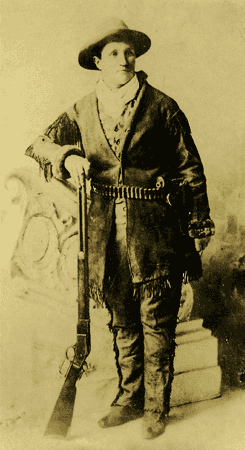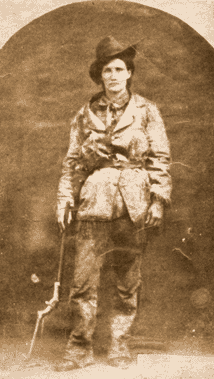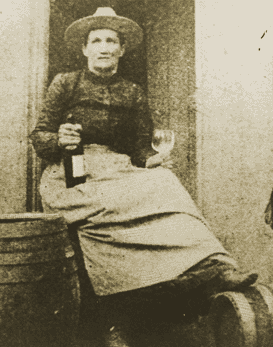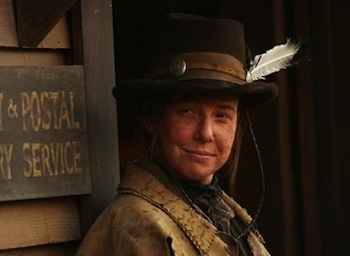 A legend like Charley Parkhurst is hard to come by — but Calamity Jane was certainly legendary in her own right. There has been plenty of speculation and unsubstantiated rumors about Martha Jane Canary — some of it straight from her own account. The city of Deadwood recognizes her as quite a storyteller, but historians agree that some of Canary’s exploits and accomplishments are indeed based on pure, undisputed facts. Below are some true stories about Calamity Jane that you may be surprised to find out:
A legend like Charley Parkhurst is hard to come by — but Calamity Jane was certainly legendary in her own right. There has been plenty of speculation and unsubstantiated rumors about Martha Jane Canary — some of it straight from her own account. The city of Deadwood recognizes her as quite a storyteller, but historians agree that some of Canary’s exploits and accomplishments are indeed based on pure, undisputed facts. Below are some true stories about Calamity Jane that you may be surprised to find out:
1. Martha Jane Canary (or Cannary) was born to Robert and Charlotte Cannary, the oldest of six siblings, in Princeton, Missouri. Her mother died of pneumonia during a wagon-train move to Virginia City, Montana — and her father died soon after moving the family to Salt Lake City, Utah. Martha Jane, now in charge of her brothers and sisters, packed up the children on the Union Pacific Railroad and settled in Piedmont, Wyoming.
2. Martha Jane was not an educated girl. She was illiterate and her knowledge was mostly based on survival skills. During her time traveling with the caravan from Missouri to Montana, she was often in the company of the party hunters, from whom she learned how to ride horses, shoot, and hunt for herself.
 3. She was described as an “extremely attractive,” “pretty, dark-eyed girl,” in her youth– but once she donned the nickname Calamity Jane, by 1876, her good looks had withered; her skin turned leathery and tanned from the sun, and she had a muscular and unfeminine look about her.
3. She was described as an “extremely attractive,” “pretty, dark-eyed girl,” in her youth– but once she donned the nickname Calamity Jane, by 1876, her good looks had withered; her skin turned leathery and tanned from the sun, and she had a muscular and unfeminine look about her.
4. Tasked with raising her 5 siblings, she took any job she could obtain in order to support her family. Accounts from those times tell us that she worked as a waitress, cook and dishwasher, as well as a dance-hall girl, a nurse, and even as an ox-team driver in Piedmont. Eventually she got work as a scout at Fort Russell in Cheyenne, and simultaneously worked as a part-time prostitute in Ft. Laramie’s Three Mile Hog Ranch.
“I figure if a girl wants to be a legend she should go ahead and be one.” — Calamity Jane
5. The first documented use of her nickname, Calamity Jane, was published in the Deadwood newspaper: The Black Hills Pioneer in July 15, 1876, boasting the headline — “Calamity Jane has arrived!”– just as the Hickok wagon train appeared in town. She first met Wild Bill Hickok that same year before coming to Deadwood — contrary to her claims that she had married him and had his child while she was stationed in Fort Russell. It is said that her rumored love affair with Wild Bill Hickok was greatly exaggerated, and spawned mostly from a great obsession and admiration on her part.
6. The wild plains were definitely harsh, and as many others, Calamity Jane had a drinking problem that couldn’t be quenched. In June 10, 1876, she set out for a buggy joy ride from Cheyenne to Fort Russell, but was so drunk that she missed her destination, ending up in Fort Laramie instead.
 7. Wild stories aside, Calamity Jane made her mark in 1875, when her company was sent to the Bog Horn River under General Crook. She swam the Platte River and traveled 90 miles at top speed to deliver important dispatches. After Wild Bill Hickok’s death, she continued to live in Deadwood. She once saved passengers from an overland stagecoach — escaping some Plains Indians who were in pursuit. The stagecoach driver was killed, so Calamity Jane took over the reins and drove the coach safely to its destination. In 1876, she played the hero again during a smallpox epidemic in the Deadwood area, being the first in line to nurse the victims back to health without concern for her own well-being. She never refused help to anyone who needed it and is remembered as a highly generous and selfless woman, as she would often put the safety of others before her own.
7. Wild stories aside, Calamity Jane made her mark in 1875, when her company was sent to the Bog Horn River under General Crook. She swam the Platte River and traveled 90 miles at top speed to deliver important dispatches. After Wild Bill Hickok’s death, she continued to live in Deadwood. She once saved passengers from an overland stagecoach — escaping some Plains Indians who were in pursuit. The stagecoach driver was killed, so Calamity Jane took over the reins and drove the coach safely to its destination. In 1876, she played the hero again during a smallpox epidemic in the Deadwood area, being the first in line to nurse the victims back to health without concern for her own well-being. She never refused help to anyone who needed it and is remembered as a highly generous and selfless woman, as she would often put the safety of others before her own.
 8. Calamity Jane’s final years are just as interesting as her earlier times. She bought a ranch near the Yellowstone River, where she managed an inn for a time. She was featured as a storyteller in Buffalo Bill’s Wild West Show in 1893, and participated in the 1901 Pan-American Exposition. Another female legend, Annie Oakley, also took part in Buffalo Bill’s Show — however she had a more active role to play as a sharpshooter; roping, and riding for the audience. Calamity Jane appeared on stage dressed in buckskins — reciting her adventures — which metastasized every time she told them. Originally it was all good clean fun, but after six months her drinking took over, and her increasing profanity ended her storytelling career.
8. Calamity Jane’s final years are just as interesting as her earlier times. She bought a ranch near the Yellowstone River, where she managed an inn for a time. She was featured as a storyteller in Buffalo Bill’s Wild West Show in 1893, and participated in the 1901 Pan-American Exposition. Another female legend, Annie Oakley, also took part in Buffalo Bill’s Show — however she had a more active role to play as a sharpshooter; roping, and riding for the audience. Calamity Jane appeared on stage dressed in buckskins — reciting her adventures — which metastasized every time she told them. Originally it was all good clean fun, but after six months her drinking took over, and her increasing profanity ended her storytelling career.
9. From what history tells us, Calamity Jane seems to have died from alcohol poisoning, or from an illness contracted from imbibing too much alcohol — she was traveling by train and drinking heavily on board when she became ill. The train conductor transferred her to the Calloway Hotel nearby where she died, August 1, 1903. She was in her mid-50s.
10. Allegedly, Calamity Jane’s dying wish was to be buried next to Wild Bill, which might have led to the speculations about her supposed romance with him. Four men who had taken part in planning her funeral have stated — that Wild Bill Hickok had “absolutely no use” for Calamity Jane when she had been alive, so they decided to bury her next to his grave in Mount Moriah Cemetery in South Dakota, as a posthumous joke on the old frontiersman.
There have been many film and television interpretations of Calamity Jane throughout the years — the most recent being Robin Weigert’s Emmy nominated portrayal of the legendary frontiers-woman in HBO’s Original Series Deadwood. Robin Weigert just completed recording the audiobook version of Karen Kondazian’s critically acclaimed historical novel The Whip, to be released in November 2012, and available through Audible.com/TheWhip, Amazon and iTunes.











Speak Your Mind